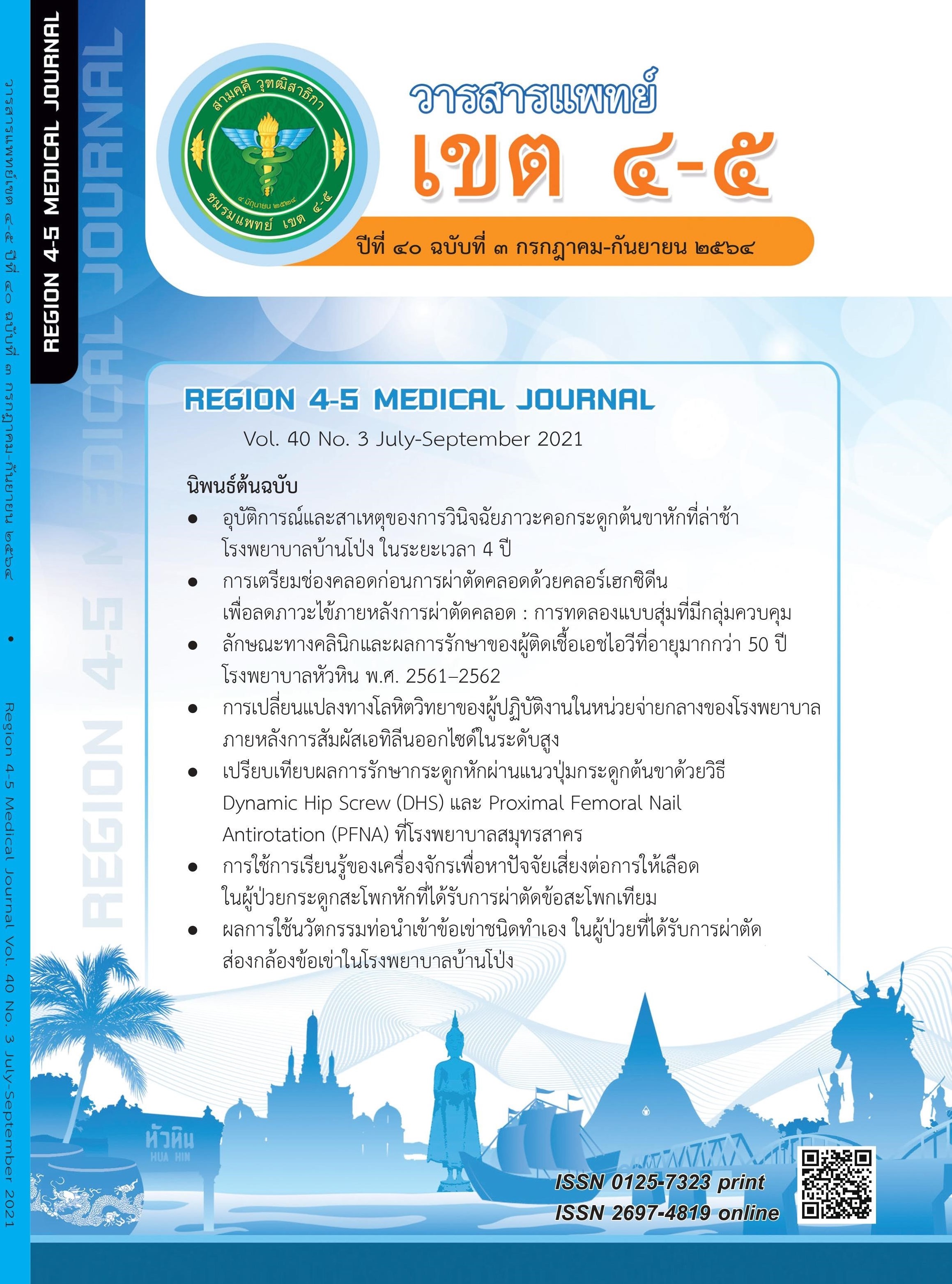การเตรียมช่องคลอดก่อนการผ่าตัดคลอดด้วยคลอร์เฮกซิดีน เพื่อลดภาวะไข้ภายหลังการผ่าตัดคลอด : การทดลองแบบสุ่มที่มีกลุ่มควบคุม
คำสำคัญ:
การเตรียมช่องคลอด, การผ่าตัดคลอด, คลอร์เฮกซิดีน, ภาวะไข้ภายหลังการผ่าตัดบทคัดย่อ
วัตถุประสงค์: เพื่อศึกษาผลของการเตรียมช่องคลอดก่อนการผ่าตัดคลอดด้วยคลอร์เฮกซิดีนต่อการลดภาวะไข้ภายหลังการผ่าตัดคลอด
วิธีการศึกษา: การทดลองนี้เป็นการทดลองแบบสุ่มที่มีกลุ่มควบคุม ที่โรงพยาบาลนครปฐม ตั้งแต่เดือนมกราคม ถึง เดือนมิถุนายน พ.ศ. 2564 โดยทำการศึกษาจากสตรีที่มารับการผ่าตัดคลอดจำนวน 200 ราย แบ่งออกเป็นสองกลุ่ม กลุ่มละ 100 ราย ทำการสุ่มเปรียบเทียบสองกลุ่มแบบง่าย กลุ่มศึกษาเป็นสตรีที่ได้รับการผ่าตัดคลอดจำนวน 100 ราย ได้รับการเตรียมผ่าตัดคลอดตามปกติทั่วไปร่วมกับการเตรียมช่องคลอดก่อนการผ่าตัดคลอดด้วยน้ำยาคลอร์เฮกซิดีน ส่วนกลุ่มควบคุมเป็นสตรีที่ได้รับการผ่าตัดคลอดจำนวน 100 ราย ได้รับการเตรียมผ่าตัดคลอดตามปกติทั่วไป โดยไม่มีการเตรียมช่องคลอด เพื่อเปรียบเทียบภาวะไข้ภายหลังการผ่าตัดคลอด
ผลการศึกษา : พบว่าภาวะไข้ภายหลังการผ่าตัดคลอดรวมทั้งหมดร้อยละ 16 กลุ่มศึกษาพบภาวะไข้ร้อยละ 13 ส่วนกลุ่มควบคุมพบภาวะไข้ร้อยละ 19 ซึ่งไม่มีความแตกต่างกันอย่างมีนัยสำคัญทางสถิติ (p-value = .335)
สรุป: ประสิทธิภาพของการเตรียมช่องคลอดก่อนการผ่าตัดคลอดด้วยคลอร์เฮกซิดีน ต่อการลดภาวะไข้ภายหลังการผ่าตัดคลอด ไม่แตกต่างกันอย่างมีนัยสำคัญทางสถิติกับการเตรียมผ่าตัดคลอดตามปกติโดยทั่วไป
เอกสารอ้างอิง
2. Digital NHS Maternity Statistics. NHS Maternity Statistics, England 2017–18. Leeds, UK:Health and Social Care Information Centre;2018.
3. Liabsuetrakul T, Sukmanee J, Thungthong J, et al. Trend of cesarean section rates and correlations with adverse maternal and neonatal outcomes:a secondary analysis of Thai universal coverage scheme data. AJP Rep. 2019;9(4):e328–36.
4. French LM, Smaill FM. Antibiotic regimens for endometritis after delivery. Cochrane Database Syst Rev 2004: CD001067.
5. Yokoe DS, Christiansen CL, Johnson R, et al. Epidemiology of and surveillance for postpartum infections. Emerg Infect Dis. 2001;7:837-41.
6. Yonekura ML. Risk factors for postcesarean endomyometritis. Am J Med 1985;78:177-87.
7. Guldholt I, Espersen T. Maternal febrile morbidity after cesarean section. Acta Obstet Gynecol Scand. 1987;66(8):675-9. doi: 10.3109/00016348709004141.
8. Martens MG, Faro S, Maccato M, et al. Susceptibility of female pelvic pathogens to oral antibiotic agents in patients who develop postpartum endometritis. Am J Obstet Gynecol 1991;164:1383-6.
9. Barwolff S, Sohr D, Geffers C, et al. Reduction of surgical site infections after caesarean delivery using surveillance. J Hosp Infect 2006;64(2):156-61.
10. Watts DH, Hillier SL, Eschenbach DA. Upper genital tract isolates at delivery as predictors of postcesarean infections among women receiving antibiotic prophylaxis. Obstet Gynecol 1991;77(2):287-92.
11. Haas DM, Morgan S, Contreras K. Vaginal preparation with antiseptic solution before cesarean section for preventing postoperative infections. Cochrane Database Syst Rev. 2014;12:CD007892.
12. Intrapartum Care. Care of healthy women and their babies during childbirth. London:2014 National Collaborating Centre for Women’s and Children’s Health;2014.
13. American College of Obstetricians and Gynecologists Women's Health Care Physicians; Committee on Gynecologic Practice. Committee opinion no. 571:solutions for surgical preparation of the vagina. Obstet Gynecol. 2013;122(3):718–22.
14. Tuuli MG, Liu J, Stout MJ, et al. A randomized trial comparing skin antiseptic agents at cesarean delivery. N Engl J Med 2016;374:647–55.
15. Ahmed MR, Aref NK, Sayed Ahmed WA, et al. Chlorhexidine vaginal wipes prior to elective cesarean section: does it reduce infectious morbidity? A randomized trial. J Matern Fetal Neonatal Med 2017;30:1484–7.
16. Haas DM, Morgan S, Contreras K. Vaginal preparation with antiseptic solution before cesarean section for preventing post- operative infections. Cochrane Database Syst Rev 2014;12: CD007892.
17. Eason EL, Sampalis JS, Hemmings R, et al .Povidone-iodine gel vaginal antisepsis for abdominal hysterectomy. Am J Obstet Gyn 1997;176:1011-6.
18. Starr RV, Zurawski J, Ismail M. Preoperative vaginal preparation with povidone–iodine and the risk of post-cesarean endometritis. Obstet Gynecol 2005;105:1024–9.
19. Guzman MA, Prien SD, Blann DW. Post-cesarean related infection and vaginal preparation with povidone–iodine revisited. Prim Care Update for Obstet Gynecol 2002;9:206–9.
20. Aschania M, Mirblouk F, Shakiba M, et al. Preoperative vaginal preparation with povidone-iodine on post-caesarean infectious morbidity. J Obstet Gynaecol 2011;31:400–3.
21. Taha TE, Biggar R, Broadhead RL, et al. Effect of cleansing the birth canal with antiseptic solution on maternal and newborn morbidity and mortality in Malawi: clinical trial. BMJ 1997;315: 216–19.
22. Haas DM, Morgan S, Contreras K, et al. Vaginal preparation with antiseptic solution before cesarean section for preventing postoperative infections. Cochrane Database Syst Rev. 2018;7:CD007892. doi:10.1002/14651858.CD007892.pub6
23. La Rosa M, Jauk V, Saade G, et al. Institutional protocols for vaginal preparation with antiseptic solution and surgical site infection rate in women undergoing cesarean delivery during labor. Obstet Gynecol. 2018;132(02):371–376.
ดาวน์โหลด
เผยแพร่แล้ว
รูปแบบการอ้างอิง
ฉบับ
ประเภทบทความ
สัญญาอนุญาต
ลิขสิทธิ์บทความเป็นของผู้เขียนบทความ แต่หากผลงานของท่านได้รับการพิจารณาตีพิมพ์ลงวารสารแพทย์เขต 4-5 จะคงไว้ซึ่งสิทธิ์ในการตีพิมพ์ครั้งแรกด้วยเหตุที่บทความจะปรากฎในวารสารที่เข้าถึงได้ จึงอนุญาตให้นำบทความในวารสารไปใช้ประโยชน์ได้ในเชิงวิชาการโดยจำเป็นต้องมีการอ้างอิงถึงชื่อวารสารอย่างถูกต้อง แต่ไม่อนุญาตให้นำไปใช้ในเชิงพาณิชย์




